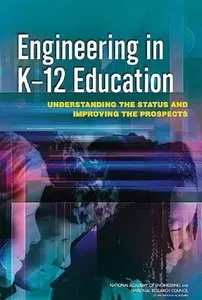"Engineering in K-12 Education: Understanding the Status and Improving the Prospects" ed. by Linda Katehi, Greg Pearson, and Michael Feder
Committee on K-12 Engineering Education; National Academy of Engineering and National Research Council
NAS Press | 2009 | ISBN: 0309137780 9780309137782 9780309137799 | 595 pages | PDF | 2 MB
Committee on K-12 Engineering Education; National Academy of Engineering and National Research Council
NAS Press | 2009 | ISBN: 0309137780 9780309137782 9780309137799 | 595 pages | PDF | 2 MB
Engineering in K-12 Education will serve as a reference for science, technology, engineering, and math educators, policy makers, employers, and others concerned about the development of the country's technical workforce. The book will also prove useful to educational researchers, cognitive scientists, advocates for greater public understanding of engineering, and those working to boost technological and scientific literacy.
Specifically, engineering education may improve student learning and achievement in science and mathematics, increase awareness of engineering and the work of engineers, boost youth interest in pursuing engineering as a career, and increase the technological literacy of all students.
The teaching of STEM subjects in U.S. schools must be improved in order to retain U.S. competitiveness in the global economy and to develop a workforce with the knowledge and skills to address technical and technological issues.
The book also analyzes a number of K-12 engineering curricula in depth and discusses what is known from the cognitive sciences about how children learn engineering-related concepts and skills.
Contents
SUMMARY
1 INTRODUCTION
Current K–12 STEM Education
The Study and Report
References
Annex
2 WHAT IS ENGINEERING?
A Brief History of the Engineering Profession
The Role of Engineering in Modern Society
Design as a Problem-Solving Process
Important Concepts in Engineering
The Relationship of Engineering to Science and Mathematics
Engineering in the Twenty-First Century
References
3 THE CASE FOR K–12 ENGINEERING EDUCATION
The Benefits of K–12 Engineering Education
Limitations of the Data
References
4 THE CURRENT STATE OF K–12 ENGINEERING EDUCATION
Review of Curricula
Conceptual Model of Engineering Curricula
Professional Development
Obstacles Facing Professional Development Programs
References
Annex: Pre-University Engineering Education in Other Countries
5 TEACHING AND LEARNING CORE ENGINEERING CONCEPTS AND SKILLS IN GRADES K–12
Engineering Concepts
Engineering Skills
Lessons Learned
References
6 FINDINGS AND RECOMMENDATIONS
General Principles for K–12 Engineering Education
The Scope of K–12 Engineering Education
Impacts of K–12 Engineering Education
The Nature of K–12 Engineering Education
Policy and Program Issues
Integrated STEM Education
A Final Word
References
Annex: Three Case Studies
APPENDIXES
A Committee Biographies
B Curriculum Projects—Descriptive Summaries
C Curriculum Projects—Detailed Analyses
- Building Math
- City Technology
- Design and Discovery
- Engineering is Elementary
- Engineering the Future
- Ford Partnership for Advanced Studies
- Full Option Science System (FOSS)
- The Infinity Project
- Invention, Innovation, and Inquiry (I3)
- Materials World Modules
- PLTW: Gateway to Technology
- PLTW: Introduction to Engineering Design
- A World in Motion® Elementary
- A World in Motion® Middle School
INDEX
with TOC BookMarkLinks



